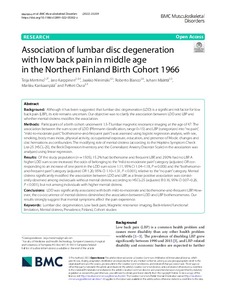Association of lumbar disc degeneration with low back pain in middle age in the Northern Finland Birth Cohort 1966
Mertimo Teija; Karppinen Jaro; Niinimäki Jaakko; Blanco Roberto; Määttä Juhani; Kankaanpää Markku; Oura Petteri
https://urn.fi/URN:NBN:fi-fe2022081154925
Tiivistelmä
Background: Although it has been suggested that lumbar disc degeneration (LDD) is a significant risk factor for low back pain (LBP), its role remains uncertain. Our objective was to clarify the association between LDD and LBP and whether mental distress modifies the association.
Methods: Participants of a birth cohort underwent 1.5-T lumbar magnetic resonance imaging at the age of 47. The association between the sum score of LDD (Pfirrmann classification, range 0-15) and LBP (categorized into "no pain", "mild-to-moderate pain", "bothersome-and-frequent pain") was assessed using logistic regression analysis, with sex, smoking, body mass index, physical activity, occupational exposure, education, and presence of Modic changes and disc herniations as confounders. The modifying role of mental distress (according to the Hopkins Symptom Check List-25 [HSCL-25], the Beck Depression Inventory and the Generalized Anxiety Disorder Scale) in the association was analyzed using linear regression.
Results: Of the study population (n = 1505), 15.2% had bothersome and frequent LBP, and 29.0% had no LBP. A higher LDD sum score increased the odds of belonging to the "mild-to-moderate pain" category (adjusted OR corresponding to an increase of one point in the LDD sum score 1.11, 95% CI 1.04-1.18, P = 0.003) and the "bothersome-and-frequent pain" category (adjusted OR 1.20, 95% CI 1.10-1.31, P < 0.001), relative to the "no pain" category. Mental distress significantly modified the association between LDD and LBP, as a linear positive association was consistently observed among individuals without mental distress according to HSCL-25 (adjusted B 0.16, 95% CI 0.07-0.26, P < 0.001), but not among individuals with higher mental distress.
Conclusions: LDD was significantly associated with both mild-to-moderate and bothersome-and-frequent LBP. However, the co-occurrence of mental distress diminished the association between LDD and LBP bothersomeness. Our results strongly suggest that mental symptoms affect the pain experience.
Kokoelmat
- Rinnakkaistallenteet [27094]
